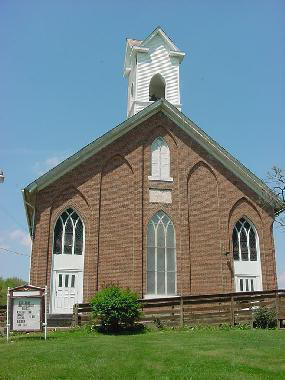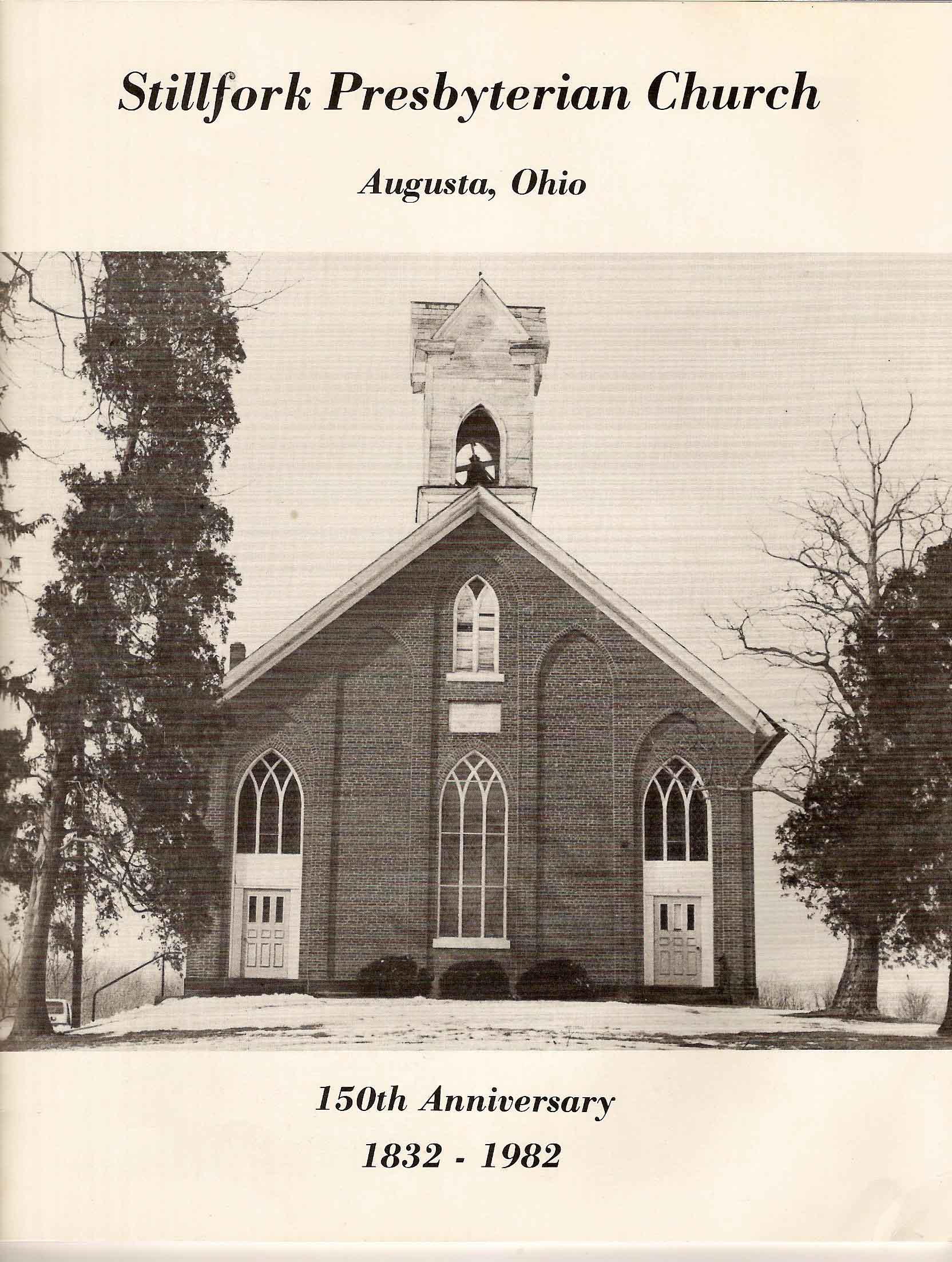History of Augusta Township
by Taylor C. Woodward
STILLFORK PRESBYTERIAN CHURCH

A church called "Stillfork" was organized March 26, 1832, by Rev. James McKean. The following elders were elected: John Potter, Andrew Watson, David Hyatt, and Robert Gibson. June 15, 1832 Andrew Watson and John Potter were ordained, and on the 16th, the following 9 members were received into the Church as charter members: Andrew Watson, Jane Watson, David Hyatt, Elizabeth Hyatt, John Pottor, Henry Pottor, Hannah Morledge, Mary Watson, and Sarah Vanhorn.
Thomas Conley donated the land for the church and cemetery. It was erected in 1832 by donations of labor. It was a small log building, called then the "Meeting House," located on the hill south of Pattersonville, and derives its name from Stillfork Creek. The cemetery marks the site. The furnishings of the church were crude, the seats were slabs of unhewn logs with wooden pegs, the pulpit was elevated and reached by a flight of stairs. One minister was so small that he had to stand on a box behind the pulpit to be seen.
During the summer, two sermons were preached each Sabbath, with a brief intermission at noon for a light luncheon. There were few hymn books. Two lines of a hymn were read, and all joined in singing them, then two more lines and so on to the end of hymn; this method was called "lining out." Two men, who were called clerks, stood at each end of the pulpit and led the singing.
The Bible "Itself" was used in Sabbath School and whole chapters committed. The shorter catechism was committed and recited to the minister when he visited the home.
Strict discipline was enforced in matters that seem trivial at the present time. It is noted in the records, that a member came voluntarily to the session and confessed that he had quarreled with a neighbor and used profane language, for which he was sorry; according to their verdict, he was admonished by the minister, a statement read from the pulpit, and then restored to his former standing in the Church.
This church building was occupied for 24 years. The ministers during this period were: James McKean, Swaney, Merl and Broof. The pastorate of McKean lasted for 14 years. 106 were received into the Church, during this period.
The second church was built in 1856, between Pattersonville and
Augusta. It was chosen as a central location; the site is
marked by a cemetery. The land was donated by
John Cameron. The building committee were: Thomas
Conley, Jesse Phillips,
John Cameron, and
Alexander Mills. It was built by
Daniel Sheckler, and was a well built frame building, painted
white, and large enough to accommodate the large congregations that
finally assembled.
The succeeding ten years are considered the darkest in its history. The weevil destroyed the wheat, and the destructive frost of 1859 blighted the farmers' prospects. The Civil War followed with all its horrors, but the church maintained its trust in God, and had regular worship.
During the 26 years that this church was occupied, a great many changes took place. Hymn books were supplied and lining out discontinued, an organ was purchased, candles were discarded for kerosene lamps and many other changes.
There were 158 members received into the church during this period. It was supplied by the following ministers: Rev's. J. B. Miller, Scott, Simpson, Dalzel, Joseph Patterson, J. B. Miller for the second time, and Eaton.
The present church was built in 1882. The building committee were: Rev. Eaton, J. D. Patterson, George Leyda, Isaac Cox, William Cameron, John Kennedy and George Gans. John Smith had the contract for the carpenter work. The brick were made by James Daniel, on the farm where George Kinsey resides. The following masons were employed: Jason Dumbleton, Joseph Arthur, John McBane, Andrew Emmons, James, David, and Charles Daniel.
During the first 50 years this church had been occupied, it was supplied by the following ministers: Rev's. Eaton, Hays, Gaily, Young, Donnell, Dickey, Grimes, Hodil - 6 years, Duffield, Ward, Richie, Wilson, Conrad, Hanna, Davidson, Nagle, Taylor - 3 years.
by Taylor C. Woodward

STILLFORK PRESBYTERIAN CHURCH

The following
taken from the history of the church, given at the 100th anniversary
of the church.
A church called "Stillfork" was organized March 26, 1832, by Rev. James McKean. The following elders were elected: John Potter, Andrew Watson, David Hyatt, and Robert Gibson. June 15, 1832 Andrew Watson and John Potter were ordained, and on the 16th, the following 9 members were received into the Church as charter members: Andrew Watson, Jane Watson, David Hyatt, Elizabeth Hyatt, John Pottor, Henry Pottor, Hannah Morledge, Mary Watson, and Sarah Vanhorn.
Thomas Conley donated the land for the church and cemetery. It was erected in 1832 by donations of labor. It was a small log building, called then the "Meeting House," located on the hill south of Pattersonville, and derives its name from Stillfork Creek. The cemetery marks the site. The furnishings of the church were crude, the seats were slabs of unhewn logs with wooden pegs, the pulpit was elevated and reached by a flight of stairs. One minister was so small that he had to stand on a box behind the pulpit to be seen.
During the summer, two sermons were preached each Sabbath, with a brief intermission at noon for a light luncheon. There were few hymn books. Two lines of a hymn were read, and all joined in singing them, then two more lines and so on to the end of hymn; this method was called "lining out." Two men, who were called clerks, stood at each end of the pulpit and led the singing.
The Bible "Itself" was used in Sabbath School and whole chapters committed. The shorter catechism was committed and recited to the minister when he visited the home.
Strict discipline was enforced in matters that seem trivial at the present time. It is noted in the records, that a member came voluntarily to the session and confessed that he had quarreled with a neighbor and used profane language, for which he was sorry; according to their verdict, he was admonished by the minister, a statement read from the pulpit, and then restored to his former standing in the Church.
This church building was occupied for 24 years. The ministers during this period were: James McKean, Swaney, Merl and Broof. The pastorate of McKean lasted for 14 years. 106 were received into the Church, during this period.
The succeeding ten years are considered the darkest in its history. The weevil destroyed the wheat, and the destructive frost of 1859 blighted the farmers' prospects. The Civil War followed with all its horrors, but the church maintained its trust in God, and had regular worship.
During the 26 years that this church was occupied, a great many changes took place. Hymn books were supplied and lining out discontinued, an organ was purchased, candles were discarded for kerosene lamps and many other changes.
There were 158 members received into the church during this period. It was supplied by the following ministers: Rev's. J. B. Miller, Scott, Simpson, Dalzel, Joseph Patterson, J. B. Miller for the second time, and Eaton.
The present church was built in 1882. The building committee were: Rev. Eaton, J. D. Patterson, George Leyda, Isaac Cox, William Cameron, John Kennedy and George Gans. John Smith had the contract for the carpenter work. The brick were made by James Daniel, on the farm where George Kinsey resides. The following masons were employed: Jason Dumbleton, Joseph Arthur, John McBane, Andrew Emmons, James, David, and Charles Daniel.
During the first 50 years this church had been occupied, it was supplied by the following ministers: Rev's. Eaton, Hays, Gaily, Young, Donnell, Dickey, Grimes, Hodil - 6 years, Duffield, Ward, Richie, Wilson, Conrad, Hanna, Davidson, Nagle, Taylor - 3 years.


